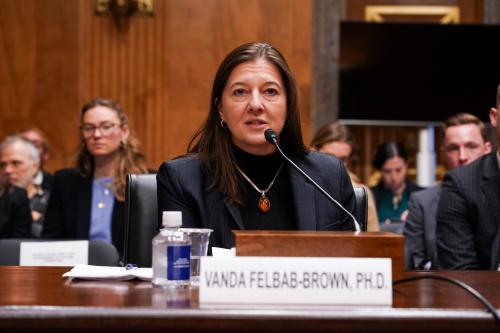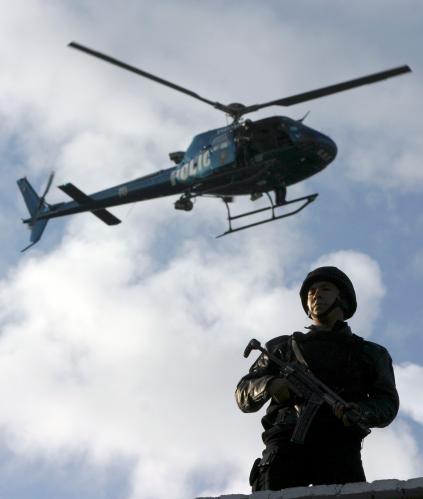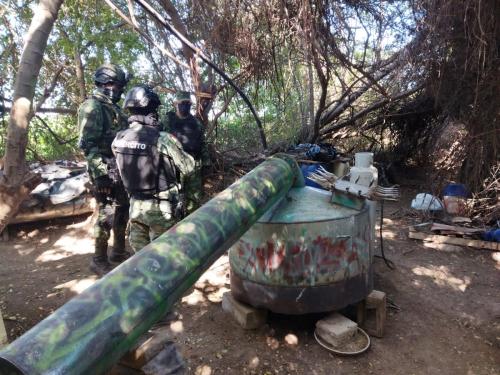On July 25, U.S. law enforcement arrested two leading bosses of Mexico’s Sinaloa cartel, one of the world’s most powerful criminal groups and a principal supplier of fentanyl to the United States: Ismael Zambada García, known as “El Mayo,” and Joaquín Guzmán López. El Mayo’s arrest is a spectacular tactical success for U.S. law enforcement, especially given the masterful no-shots-fired trickery that led to it. It finally brings justice to the many victims of El Mayo’s violence and drug peddling.
But is the arrest going to prove a strategic success for U.S. law enforcement? Or will it be yet another instance of the glamor and simplistic thinking of high-value targeting (HVT) seducing the United States into strategically counterproductive moves?
Like other arrests of high-value targets in Mexico, it will not significantly reduce flows of fentanyl or other drugs. But it will likely augment the already very intense criminal violence in Mexico and possibly leave behind a criminal market even more threatening to the United States. Several factors could offset this result in terms of the threat calculus for the United States, chief among them what information El Mayo provides to U.S. law enforcement on the immense corruption at the top of Mexico’s political and government circles and security services.
The background to the arrests
Months of tight-knit and daring work by the U.S. Homeland Security Investigations (HSI) office and the Federal Bureau of Investigations apparently preceded the arrest, demonstrating once again the continually-amazing deep infiltration into Mexican criminal groups that U.S. law enforcement has been able to develop and maintain over many years. In the final stage, according to U.S. law enforcement, Joaquín Guzmán López tricked El Mayo into boarding a private plane, ostensibly to inspect the Sinaloa cartel’s drug airstrips in northern Mexico. The plane in fact landed in the United States. While it is not clear how much U.S. law enforcement knew in advance, Joaquín apparently decided to sweeten his own surrender deal of shorter and nicer terms of imprisonment by throwing El Mayo under the bus to help his brother Ovidio Guzmán López. A key driver of Sinaloa cartel’s decision a decade ago to fully embrace fentanyl trafficking to the United States irrespective of the death toll and with brash violent proclivities, Ovidio is in prison and awaiting trial in the United States, and potentially looking at life-long imprisonment in very tough conditions in a supermax prison like his father Joaquín Archivaldo Guzmán Loera, known as “El Chapo,” who was after repeated arrests and prison escapes in Mexico.
El Chapo and El Mayo were the founders of the cartel, building a violent, powerful, and deeply-politically connected criminal group in Mexico that has dominated the U.S. drug market and spans all of the Americas. For years El Mayo was a like surrogate father to the four sons of El Chapo who got involved in the cartel’s operations and eventually rose to the top leadership—Joaquín, Ovidio, Iván Archivaldo Guzmán Salazar, and Jesús Alfredo Guzmán Salazar—collectively known as the “Chapitos.”
The Chapitos expanded the Sinaloa cartel’s operations in Europe, the Asia-Pacific region, Africa, and the Middle East as well as the cartel’s takeover of many legal economies in Mexico, from fisheries to mining, logging, water distribution, and others.
El Mayo initially supported the rise of the Chapitos to the top after El Chapo’s extradition and rescued them several times, including during an internal power struggle with . As part of that support, in 2016 El Mayo negotiated the release of Iván and Jesús from the clutches of the Cartel Jalisco Nueva Generación (CNJG) and a likely very nasty fate.
But in recent years, relations between El Mayo and the Chapitos soured, and violence between the two branches began. The limelight-avoiding El Mayo, who preferred to operate behind the scenes through corruption and who was known as the cool-head negotiator and mediator among the cartel leaders, often seeking to tamper down violence, objected to the brashness of the Chapitos and especially of Ovidio. Crucially, El Mayo was allegedly highly frustrated with Ovidio and the other Chapitos’ indifference to long-standing redlines on the cartel’s behavior, including their drawing unprecedented wrath from U.S. law enforcement because of fentanyl deaths and their turning up violence even within the Sinaloa cartel’s homebase of Culiacán. The Chapitos allegedly believed that it was El Mayo who helped with intelligence that led to the second arrest of Ovidio.
For HSI, the bloodless arrest of El Mayo is a moment of graduation to the top league of undercover operations at which the Drug Enforcement Agency (DEA) excels, and the culmination of stepping into the DEA’s shoes in Mexico after it was shunned by the López Obrador government for arresting former Secretary of National Defense General Salvador Cienfuegos in 2020 for complicity in drug trafficking.
The problematic effects of high-value targeting
But strategically, El Mayo’s arrest is problematic. As I have written extensively, high-value targeting amplifies violence: It encourages infighting within factions of the same criminal group over succession, it brings to the top of organizations more violent leaders, and it stimulates rival groups to attack the turf of the group that suffered the leadership loss. HVT rarely delivers the dream outcome of simply weakening criminal groups and strengthening the state.
In Mexico, such HVT since the Felipe Calderón administration has produced an out-of-control criminal market. López Obrador made it even worse by coupling sporadic HVT with otherwise giving up on law enforcement against Mexican criminal groups. The HVT-caused violence has been terrible for the Mexican people and ultimately sapped the willingness of Mexican governments to meaningfully cooperate with U.S. law enforcement efforts.
Mexico today is a powder keg for such post-HVT violence escalation. Yes, El Mayo, elderly and suffering from diabetes, has allegedly been negotiating possible terms of surrender with U.S. law enforcement for the past several years. He may well have a succession system in his place in his branch of the Sinaloa cartel, which could reduce one aspect of post-HVT violence. But Joaquín’s betrayal will critically exacerbate the ongoing infighting between the Chapitos and El Mayo’s branch.
The fighting may also inadvertently increase the power and dominance of CJNG, a far more vicious cartel than even its archrival Sinaloa and just as implicated in fentanyl smuggling into the United States. CJNG will try take over Sinaloa’s turf and vassal criminal groups from Baja California and Cuidad Juárez all the way to Chiapas and into the state of Sinaloa itself. That would be a bad outcome for the United States as well as Mexico.
A substantial reduction of the flow of fentanyl and other drugs to the United States is unlikely. Infighting aside, the Sinaloa cartel has redundancy systems for smuggling, and two of the Chapitos are still at large, including Jesús, Sinaloa’s boss for international operations. And even if Sinaloa were to completely implode eventually, CJNG would take over Sinaloa’s fentanyl distribution to the United States as well as its other economies.
The way to avoid the violence triggering effects of HVT is middle-layer targeting that seeks to capture at once much of the leadership layer underneath the top bosses. But middle-layer targeting requires a lot of time, on-the-ground presence (unavailable for U.S. law enforcement under the López Obrador administration), and prevention of intelligence leaks, the latter difficult given extensive cartel infiltration of Mexican security and government structures.
Moreover, instead of tactical opportunism, targeting, including HVT, should be guided by a strategic decision as to what kind of shape and leadership of a criminal market or of an insurgent group is least contrary to U.S. interests. For example, the United States made a crucial strategic blunder in Afghanistan in 2016 when it killed the former leader of the Taliban, Mullah Akhtar Muhammad Mansour. That hit left behind a Taliban leadership far more opposed to U.S. interests—at that time and still today—than if the more pragmatic Mansour remained at the helm.
The United States should have rounded up the Chapitos, though they are themselves high-value targets, and gone after CNJG leadership, but left El Mayo at large for a while to stabilize the crime market and relaunch policies relatively less harmful to the United States and Mexico.
Potential strategic payoffs of El Mayo’s arrest
Three factors could offset the expected costs of greater violence in Mexico following El Mayo’s arrest:
The first is if the United States had intelligence that El Mayo was providing services to Russian intelligence agencies. Connections between him and Russian operatives have for three years, while Russian intelligence actors have been recruiting criminal groups for a wide range of anti-West operations across Europe and their presence in Mexico has also grown significantly.
The second is if there were any linkages between a Mexican criminal group and a terrorist group— though the United States has looked hard, it hasn’t found this before.
The third and by far the most likely factor would be if El Mayo provided information and evidence on the massive layers of corruption among Mexican government, security, and law enforcement officials. In addition to being the cool-headed criminal negotiator, El Mayo has been the corruptor-in-chief: His corruption networks have spanned many Mexican presidential administrations from very high levels to municipal governments across the country. If he spills the goods on them and the United States can indict many more corrupt high-level Mexican officials à la Cienfuegos and actually convict some, like in the case of former Secretary of Public Security Genero García Luna, that would be a powerful blow to Mexican criminal groups and a big boost for rule of law in Mexico.






Commentary
The Sinaloa cartel arrests: Stunning tactical success, strategic blunder?
July 26, 2024